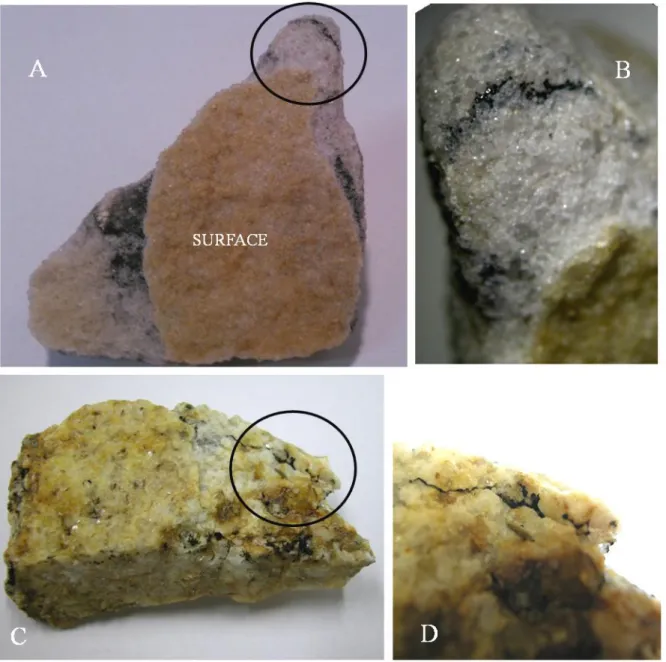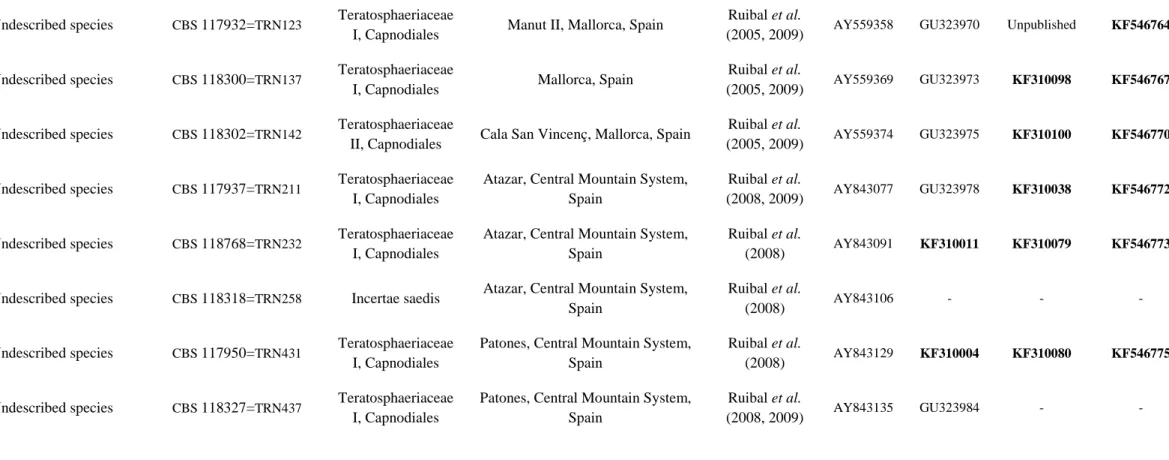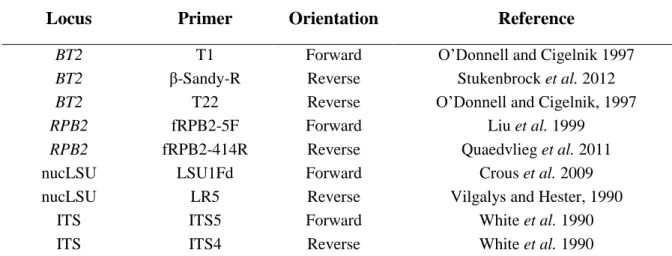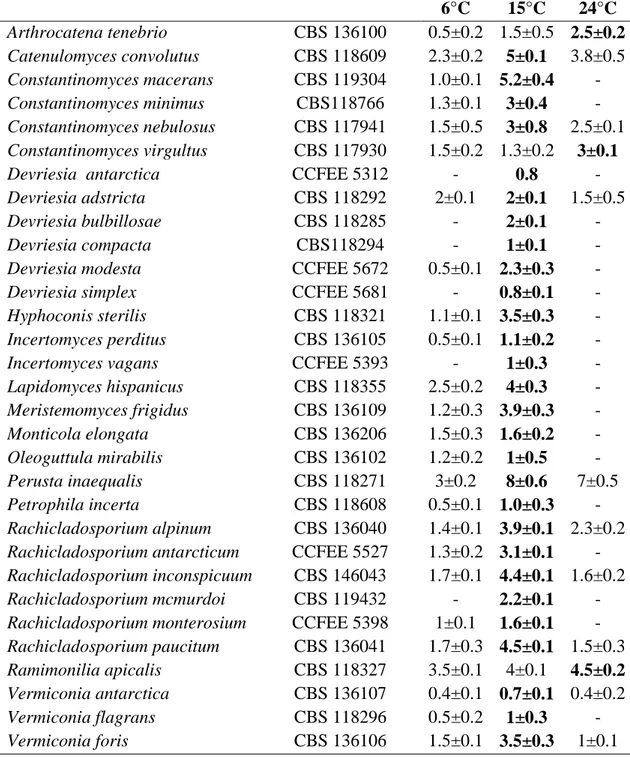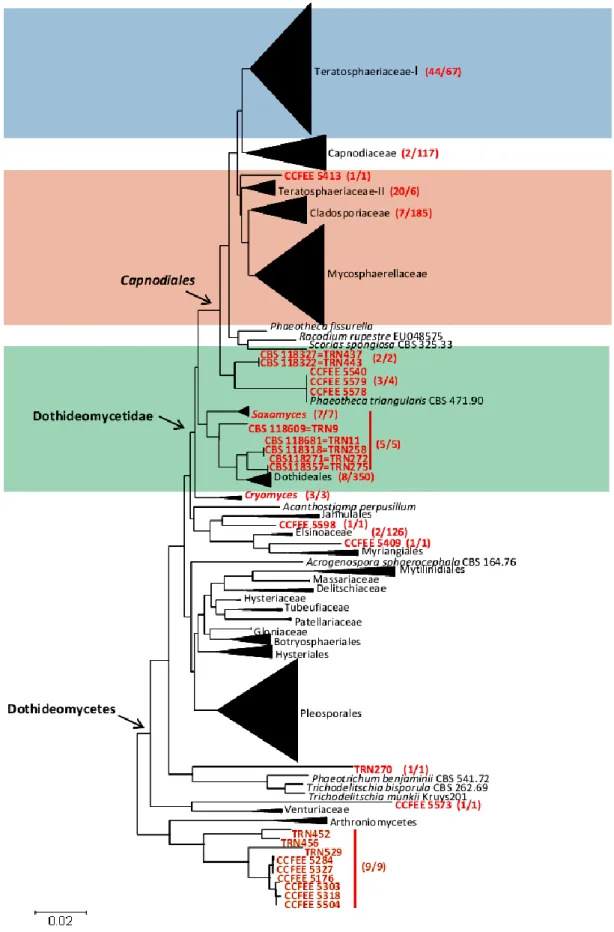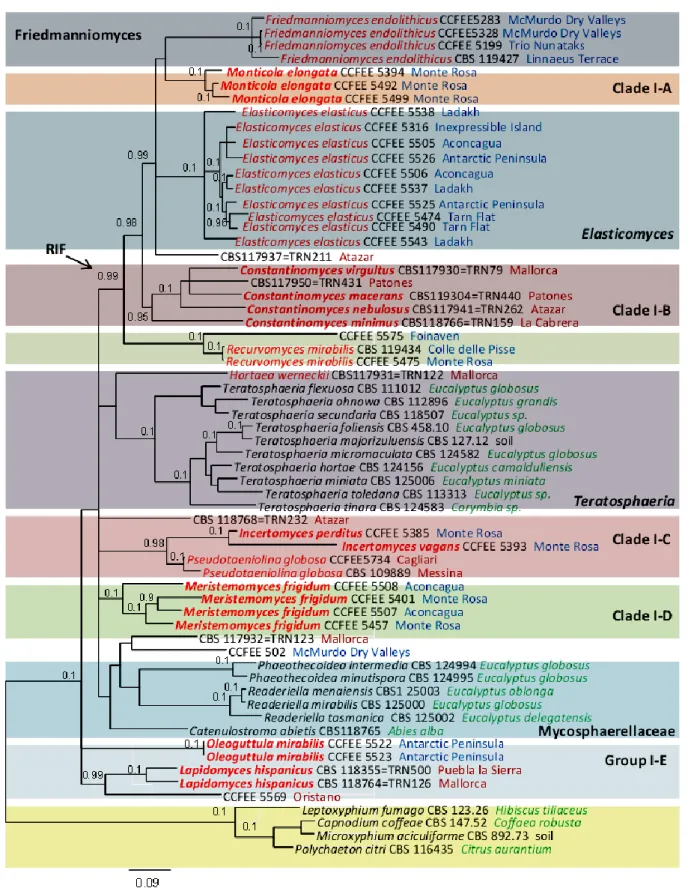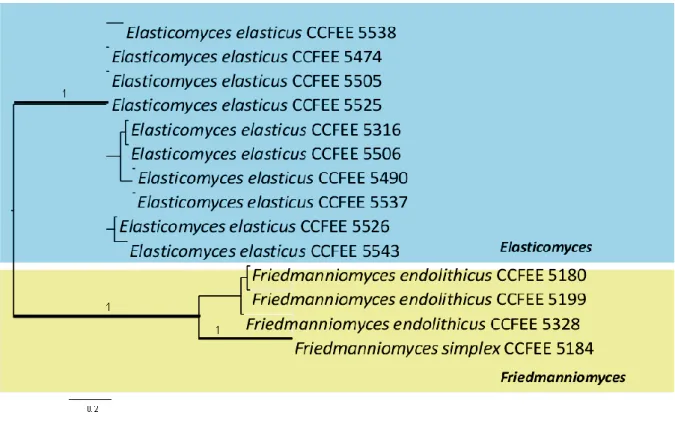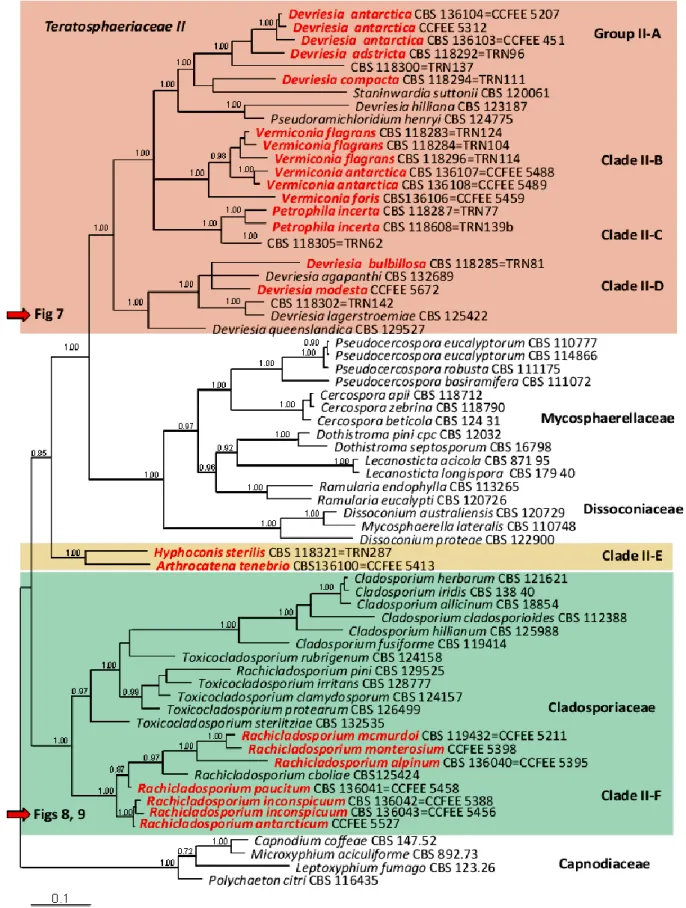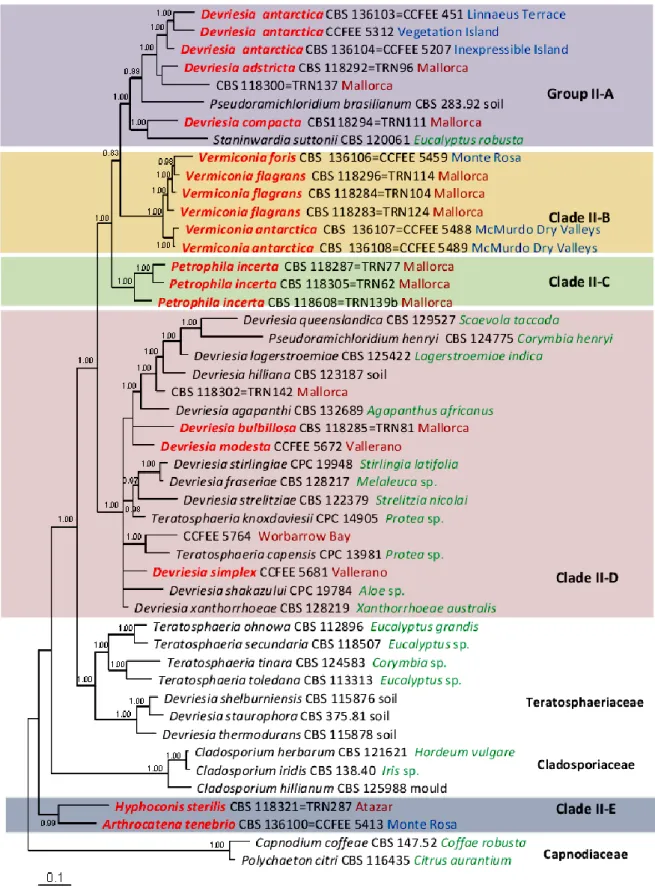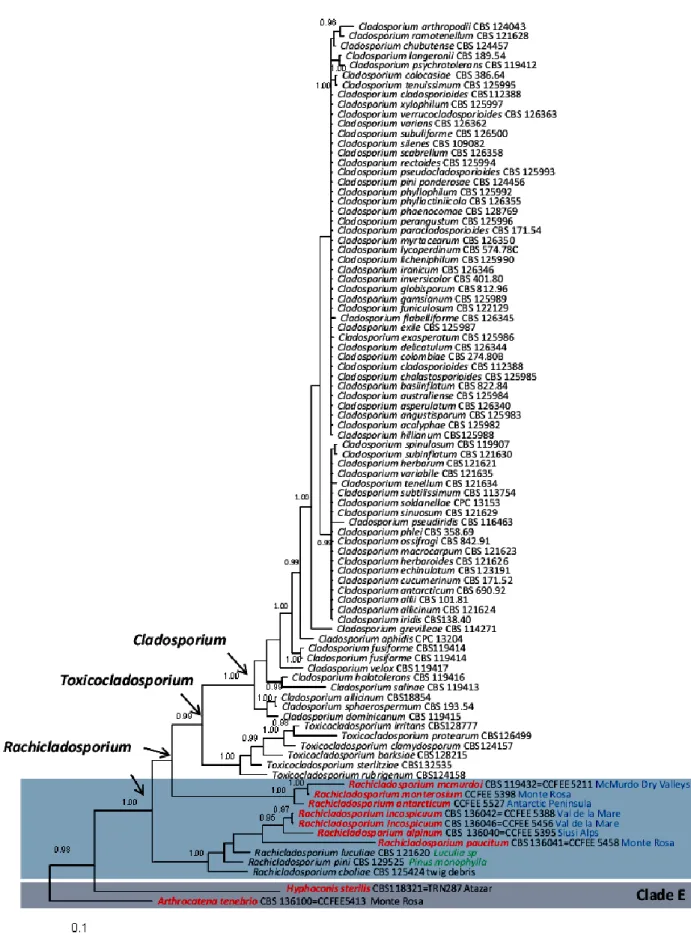1
U
NIVERSITÀ DEGLIS
TUDI DELLAT
USCIAF
ACOLTÀ DIS
CIENZEMM. FF. NN.
D
IPARTIMENTO DIS
CIENZEE
COLOGICHE EB
IOLOGICHED
OTTORATO DIR
ICERCA INE
VOLUZIONEB
IOLOGICA EB
IOCHIMICAXXVI
CICLOPhylogeny and taxonomy of meristematic rock-inhabiting black
fungi in the Dothideomycetes based on multi-locus phylogenies
( s.s.d. BIO/02)
PhD Candidate Eleonora Egidi
Coordinator Tutor Prof. Laura Zucconi Galli Fonseca Prof. Silvano Onofri
Tutor
Dott. Laura Selbmann
Tutor
2 Index
1. INTRODUCTION 3
1.1 THE ROCK SUBSTRATUM 3
1.1.1 ROCK MICROBIAL COMUNITIES 3
1.1.2 STRATEGIES FOR ROCK COLONIZATION 4
1.2 ROCK INHABITING FUNGI (RIF) 6
1.2.1 GENERAL FEATURES 6
1.2.2 DISTRIBUTION OF ROCK FUNGI 7
1.2.3 ADAPTATIVE STRATEGIES FOR SURVAVAL IN EXTREME CONDITIONS 8
1.2.4 NUTRITION 10
1.2.5 CRYOMYCES, A PARADIGMATIC GENUS 11
1.2.6 ORIGINS OF RIF: AN ESTIMATION OF DIVERGENCE TIMES 12
1.2.7 INTEREST OF MELANIZED ROCK FUNGI 13
1.3 METHODS FOR IDENTIFICATION 14
1.3.1 FROM MORPHOLOGY TO MOLECULAR TECNIQUES 14
1.3.2 ITS AS UNIVERSAL DNA BARCODE MARKER FOR FUNGI 15
1.3.3 THE MULTILOCUS APPROACH 16
1.4 PHYLOGENY 16
1.4.1 PHYLOGENY OF FUNGI: WORK IN PROGRESS 16
1.4.2 PHYLOGENETIC STUDIES ON RIF 17
2. AIM OF THE WORK 19
3. MATERIAL AND METHODS 20
3.1 ROCK SAMPLES 20
3.1.1 SAMPLING SITES 20
3.2 STRAINS ANALYSED 22
3.3 MORPHOLOGICAL EXAMINATION AND TEMPERATURE DEPENDENT GROWTH STUDY
32
3.4 DNA EXTRACTION, AMPLIFICATION AND SEQUENCING 32
3.5 PHYLOGENETIC INFERENCE 34 4. RESULTS 37 4.1 THERMAL PREFERENCES 37 4.2 PHYLOGENETIC INFERENCE 39 5. TAXONOMY 51 6. DISCUSSION 78
6.1 MOLECULAR DIVERSITY IN RIF 78
6.2 ECOLOGY OF COLD-LOVING ROCK INHABITING FUNGI 81
7. REFERENCES 83
3 1.INTRODUCTION
1.1 THE ROCK SUBSTRATUM
1.1.1 ROCK MICROBIAL COMUNITIES
Rocks can be defined as any naturally-formed, consolidated material composed of one or more minerals. Minerals are inorganic crystalline solids with a definite chemical composition (Plummer and McGeary, 1996).
Rocky substrates– at the interface between the atmosphere and a solid substrate (lithosphere) – are ancient terrestrial niches. Survival on the rocks represents an exceptional challenge for living systems, as colonizers have to face widely stressful environmental conditions and their settlement, growth and development are influenced by humidity, temperature, deposition of inorganic and organic materials and nutrients and intense solar irradiation. Physical conditions are characterized by wide and constant changes (Gorbushina, 2007) and all these combined stress factors involve an high selective pressure which limits the successful development of cosmopolitan organisms (Sterflinger, 2005).
Specialized microbial communities, called SubAerial Biofilms (SAB) (Gorbushina and Krumbein, 2000) represent a group of ubiquitous, self-sufficient microbial ecosystems which evolved specialization to survive in this extreme ecological niche thanks to a collective growth habit. They represent a crucial and ancient element having a large impact on the evolution of Earth and life on Earth. Sedimentary rock formations have been influenced by the active participation of biofilms throughout the entire geological history of the Earth (Cooke and Whipps, 1993; Krumbein and Lapo, 1996).
SAB are specialized in successful colonization of sediments and rocky surfaces from different hot and cold environments, and at all latitudes where direct contact with the atmosphere and solar radiation occurs (Costerton et al. 1987; Guezennec et al. 1998; Ortega-Morales et al. 2001) Recently, Gorbushina et al. (2000) proposed the idea that “poikilotrophy” and sub-aerial biofilm community are a specific type of strategy developed for survival in harsh environments.
The role of SAB in rock erosion’s process resulted to be essential for soil and vegetation development (Ehlich, 1996; Chertov et al. 2004), as microorganisms promote mineral diagenesis (which can be generally defined as the transformation of a mineral into a different one) and dissolution. An important contribution to the weathering process can be the result of the excretion of
4
metabolites, which cause the dissolution of the host-rock through chemical attack on mineral surfaces (Johnstone and Vestal, 1992; Ehrlich, 1998; Gadd and Sayer, 2000). Cyanobacteria and archea are considered the first microbial association of organisms able to colonize terrestrial surfaces, followed by eukaryotic forms (Margulis, 1970; 1982). Algae, fungi and protists, the first eukaryotic organisms conquering terrestrial environment, resulted to be able to resist to stress exposition better than prokaryotes, developing sophisticated survival strategies which led to lichens and plants evolution (McMenamin and McMenamin, 1994).
Nowadays SAB are composed by a complex consortium of bacteria, algae, fungi and lichens, whose composition varies according to nutrients availability and stress factors’ fluctuations, even if mechanisms of interaction are still poorly understood (Gorbushina, 2007).
Lithic communities are characterized by polysaccharides extra cellular matrix production (EPS) (Wimpenny, 2000; de los Rios et al. 2002; Kemmling et al. 2004; Omelon et al. 2006), crucial in promoting interactions between organisms, atmosphere and substrate. In particular, EPS (i) facilitate connections among microorganisms, which stimulate bacterial growth and contact with photobionts (Gorbushina et. al. 2005); (ii) change according to atmospheric and climatic modifications; (iii) limit osmotic stress thanks to water retention capability, allowing community survival during scarce water availability periods (Neu, 1996; Potts, 1999; Decho, 2000; Gorbushina, 2007).
1.1.2 STRATEGIES FOR ROCK COLONIZATION
Lithic communities can be restricted to rock surface (epilithic) or expand underneath rock crust (endolithic). Endolithic niche is colonized through different strategies by microbial communities; euendolithic organisms (mostly crusty lichens) penetrate the substrate by active perforation, chasmoendolithic microbes take advantage of natural rock fissures, while the so called criptoendolithic communities live in the airspaces or structural cavities in rocks (Golubic et al. 1981; Friedmann et al. 1982). In Fig. 1 a few examples of epilitic, chasmoendolithic and criptoendolithic colonizations are shown.
5
Fig. 1. A. Sandstone with endolithic colonization. B. Detail of endolithic colonization. C, D. Granitoid showing epilithic (lichens) and chasmoendolithic colonization
6
Biofilms tendency toward inner rocky substrate colonization can be explained by the necessity of communities to find new and sheltered ecological niches. In fact, during the day and among different seasons, rocks are subject to irregular and wide fluctuations of temperature, humidity and irradiation; temperatures are influenced by solar irradiation and air temperature and, especially in destert areas, can reach extremely low or high temperatures. For example, in Linnaeus Terrace (McMurdo Dry Valleys, Antarctica), rock surfaces have an average winter generally 2 °C below the outside air temperature, ranging in 1985 from -47.2 °C to -19.4 °C, while summer temperatures on rock surface temperature may reach 20 °C above that of outside air. (Friedmann et al. 1987). SAB in general, experience high water availability is variable and biofilms run from drought to torrential rains which leave them completely wet. Infrared and UV radiations can be relatively low in the night but extremely high during summer days; in particular high doses of radiations affect mountain sites, deserts and Equator-oriented surfaces. Nutrients availability varies from zero to abundance. In these environments, microorganisms are forced to stress induced dormancy, interrupted by the occasional return of growth-permissive conditions (Gorbushina, 2007).
In order to successfully colonize rock surfaces, SAB employ several physical strategies of penetrating rock, to acquire shelter against extreme environmental influences. They can deepen existing fissures and cracks (Pinna and Salvadori, 1999) or intercrystalline airspaces of rock material (Friedmann, 1982; Urzì and Realini, 1998; Sterflinger et al. 1997). Intracrystalline penetration was also observed (Gorbushina, 2007; Favero-Longo et al. 2011).
Specific features of substrate can widely influence microbes’ ability to colonize rocks. Physical characteristics, such as porosity, and chemical composition are crucial to determine SAB growth and survival and can force selective pressure on microbial populations in situ (Gleeson et al. 2005).
1.2 ROCK INHABITING FUNGI (RIF)
1.2.1 GENERAL FEATURES
RIF are extremophile or extremotollerant organisms showing peculiar common features which allow their survival in oligotrophic environments characterized by extremely high or low temperatures, high UV radiation and osmotic stress combined together. They are usually melanized and organized in microscopic colonies on the rocky substrate, so they are also called black yeasts (Sterflinger, 2005) or microcolonial fungi (MCF) (Staley et al. 1982); because of their ability to form cells’ clumps with a peculiar isodiametric, they are also called meristematic fungi (Sterflinger et al. 1999).
7
Rock surfaces represent an habitat where only extremotolerant, specialized organisms are able to survive (Gorbushina and Krumbein, 1999; Sterflinger and Krumbein, 1997; Isola et al. 2013b). In this framework, rock-inhabiting fungi (RIF) are efficient lithic substrate colonizers (Staley et al. 1982; Braams, 1992; May et al. 1993; Sterflinger, 2000) and important component of epilithic and endolitic microbial communities. An high degree of specialization and adaptation make RIF predominant organisms in SAB (Gorbushina et al. 1993; Wollenzien et al. 1995). Furthermore, the degree of stress tolerance make fungi the most diverse biota in the Continental Antarctica, one of the most extreme environment on Earth, a continent dominated by microorganisms, where plants are absent (Bridge and Spooner, 2012).
Thanks to complex biomechanical and biochemical processes, they are able to successfully interact with minerals and organic compounds, assuming a crucial role in biogeochemical metabolic process of fixation of nutrients (C, N, P, S) and metals ( essential -Na, Mg, Ca, Mn, Fe, Cu, Zn, Co, Ni- and not essential -Cs, Al, Cd, Hg, Pb), necessary for living organisms survival (Buford et al. 2003).
1.2.2 DISTRIBUTION OF ROCK FUNGI
First discovered in hot and cold deserts (Friedmann, 1982, Staley et al. 1982), RIF are now known to be ubiquitous on hard surfaces, in extreme as well as in temperate climates (Urzì et al. 1994; Sterflinger and Prillinger, 2001; Gorbushina, 2007; Gorbushina and Broughton, 2009; Ruibal et al. 2005; 2008; Zucconi et al. 2012). Sampling campaigns conducted in the last fifteen years showed that black fungi are commonly found in both cold and dry climates, from natural rocks to monuments, wherever conditions prevent the settlement of cosmopolitan, fast growing fungi (Gorbushina et al. 2007).
Different studies detected an impressive fungal diversity in Mediterranean zone, even in restricted sampling areas: Ruibal et al. (2005; 2008) focused on sampling sites from Spanish Central Mountain System and Mallorca, revealing that only few isolates can be addressed to formally described species from genera Hortaea, Capnobotryella, Catenulostroma, Sarcinomyces, Coniosporium, Capronia, while most fungi belong to new taxa. Fungi from the genera Sarcinomyces and Phaeococcomyces are recurrent in different areas and have been isolated from marble and calcarenite in Greece and Italy (Wollenzien et al. 1997) and from Chersonesos ruins in Crimea; they both were recently included in the genus Knufia (Tsuneda et al. 2011). A number of Capnobotryella species, with unclear phylogenetic positions, have been repeatedly found on Turkish marble monuments (Sert et al. 2007c; Sert and Sterflinger, 2010), while Pseudotaeniolina globosa have been isolated from Santa Maria di Mili church, Messina, Italy (De Leo et al. 2003) and, recently, on statues of the Boyl’s Palace in
8
Cagliari (Onofri et al. 2012). Species from the genus Exophiala, occasionally found as opportunistic rock colonizers , posses an high rate of stress tolerance but, on the other side, they are also able to react to moderate conditions by faster growth and by morphological changes from meristematic towards mycelial growth (Tesei et al. 2012).
Furthermore, black meristematic fungi are invariably found in cold deserts as well as high mountain tops. Friedmanniomyces, Cryomyces and Elasticomyces, originally isolated from Antarctic rocks, are the largest genera representing this group of highly specialized fungi (Selbmann et al. 2005; 2013; Isola, 2010). Friedmanniomyces is an endemic genus from Victoria Land, Antarctica, while
Cryomyces and Elasticomyces, originally isolated from Antarctic rocks, show to have a broader
distribution (Selbmann et al. 2005; 2013a). Recently, Saxomyces, a new genus from Alps, has been proposed (Selbmann et al. 2013a). In contrast with rock fungi from temperate environments, these fungi are highly specialized to the cold and are real extremophiles amongst the black fungi.
1.2.3 RIF ADAPTATIVE STRATEGIES FOR SURVAVAL IN EXTREME CONDITIONS
Fungi are commonly known to posses skills enabling them to colonizing and persist in novel environments, thanks to a remarkable ecological, biological and morphological plasticity (Agosta and Klemens, 2008).
Rocks are challenging niches;RIF settlement, growing and development on rocky substrates are influenced by many factors, including humidity, UV irradiation, nutrients availability. The lack of competitors caused by the high selective environmental pressure let rock fungi to focus on stress tolerance and successfully colonize prohibitive ecological niches rather than sharping their competition abilities.In particular, cells wall is thick and melanized in order to protect cells against extreme temperatures and desiccation, as well as UV irradiation. Melanins are high molecular weight pigments responsible of the characteristic dark green, brown or black color of RIF, largely contributing to their resistance to chemical and physical stresses. Melanins are negatively charged idrophobic molecules (Langerfelder et al. 2003), often aggregated to proteins and carbohydrates, formed by phenols and indolic compounds polymerization (Butler and Day, 1998). They can be DOPA-melanin (3,4-dihydroxyphenylalanine) or DHN-melanin (1,8-dihydroxynaphtalene) (Butler and Day, 1998). They are synthesized in the cell wall (Diakumaku et al. 1995; Butler and Day, 1998) or released as extracellular polymers in the cultural medium (Kogej et al. 2004). Moreover some melanized fungal species have been found in nuclear reactors and their cooling water systems, suggesting that melanins could confer a remarkable tolerance to ionizing radiation (Zhdanova et al.
9
2000), even being responsible of ionizing gamma radiation’s conversion into chemical energy by still unknown mechanisms (Dadachova et al. 2007).
Solutes such as trehalose and sucrose, which possess water- retention properties, have been widely detected in endolithic microorganisms, including RIF (Nienow and Friedmann, 1993; Wynn-Williams et al. 1999). In particular trehalose is very efficient for its cryoprotective effects during freezing or desiccation (Weinstein et al. 2000) acting as stabilizer of enzyme conformation and phospholipid bi-layers of membranes allowing these surprising organisms to survive complete dehydration (Onofri et al. 2012).
Considering the scare nutrients availability in environments where rock inhabiting fungi typically reside, the high metabolic costs for synthesizing all these compounds significantly affect growth velocity of these fungi which show a very slow growth rate. Meristematic growth (i. e. isodiametric cellular expansion) represents an additional advantage resulting in a minimal surface/volume ratio which allows survival in dry conditions (Wollenzien et al. 1995). The ability to modify cellular polarity (Yoshida et al. 1996), a scarce morphological differentiation and the capacity to rely on air-borne sparse nutrients exclusively (oligotrophism) are crucial features for extreme environments inhabiting (Gunde-Cimmerman et al. 2005; Amaral Zettler et al. 2002).
Regulation of metabolic activities is a strategy to balance energy expense according to changes in the composition of the atmosphere and climate. Sterflinger et al. (2012) suggest that in polar environments for large part of the year fungi incur dormancy, a reversible state which stops only when temperature rises and melting water is available, while fungi in hot deserts might profit from dewfall that develops during a short time before sunrise (Ninari and Berliner, 2002). Rock inhabiting fungi are invariably asexual. Indeed, keeping the genetic machinery for recombination active implies too high energetic expense, considering that fungal teleomorphs tend to be elaborate, with fruit bodies and specialized cells in which recombination takes place. Thus, in a framework where all the efforts of the cell are focused on production of few crucial metabolites in order to shelter from environmental stresses, sex represents an energetic cost that a fungus residing in extreme conditions can not afford.
Moreover, in order to decrease energy expense, the life-cycle in these fungi is extremely simplified, usually limited to just a few cells that subdivide and fall apart for passive dispersal. At most, some species exceptionally show some morphological differentiation, with tiny conidiophores as in
Recurvomyces mirabilis (Selbmann et al. 2008). The efficiency of RIF dispersal is guaranteed by
surprising means to spread. Rock black yeasts, for instance, actively penetrate and brake up the substratum and organize in wind-blown arrays of clump-like cells firmly connected with each other and with rocky substrate by EPS, which can settle elsewhere in order to grow and develop
10
successfully. Current biogeographic data suggests that long distance dispersal occurs in rock-inhabiting fungi (Gorbushina, 2007; Selbmann et al. 2008; 2013a). However, in few cases, some rock-inhabiting taxa seem to be only present in unique localities or geographical areas (Selbmann et
al. 2005).
1.2.4 NUTRITION
Nutrition represents a challenge for RIF colonizing cold, oligotrophic environments like desert, Polar or Alpine areas. Oligotrophy is an important adaptation, enabling them to rely only on sparse, airborne nutrients available as dust. Generally black fungi are metabolically scarcely competent producing only few metabolites crucial for survival (Selbmann et al. 2005; Sterflinger, 2006). They are scarcely exigent from a nutritional point of view, being slow growing and able to shift to dormant state even for long periods; they just need simple sugars for growth or easily degradable polymers resulting from photosynthesis of neighboring lichens and algae (Selbmann et al. 2013b), since in desertic and Alpine environments plants are mostly abstent or rare.
Most black yeasts have a very slow growth rate with no significant increases even when cultured on rich media; they are so adapted to the oligotrophic conditions of their natural environments that some also maintain visible mycelial growth, even for short periods, when cultivated on media with no carbon sources.
Recently, Gostinčar et al. (2012) surmised the existence of unconventional pathways of carbon acquisition as additional source of energy alternative to their cohabitation with algae. Atmospheric carbon dioxide fixation could actually exceptionally take place in fungal metabolism, although it lacks a Calvin cycle comparable to that found in plants. It was observed, using 14C-labeling, that black fungi isolated from Antarctic cryptoendolithic communities of the McMurdo Dry Valleys, the closest terrestrial analogue for Mars, may actually uptake CO2 (Palmer and Friedman, 1988). The authors’ hypotesys is that Antarctic fungi may actually incorporate CO2 by carbossilation of pyruvate (Moses et al. 1959) as it was reported earlier for a number of fungi, although definitive confirmation with a modern-approach planned experiments is still missing (Selbmann et al. 2014).. Such mechanisms could represent a life-sustaining option for slow-growing oligotrophic black fungi in extreme and competitor-free environments. The stunning ability to survive, and even thrive, in environments normally neglected or precluded for most life-form as exposed rock surfaces can be explained by these unusual strategies used by rock fungi in order to gain energy.
11
1.2.5 CRYOMYCES, A PARADIGMATIC GENUS
A paradigmatic exemple of rock inhabiting fungi’s tolerance to environmental stresses is represented by the genus Cryomyces, whose representatives have been isolated from cold Antarctic and Alpine rocks. As recently reviewed by Selbmann et al. (2013c), during last years Cryomyces spp. have been subjected to a number of experiments in order to test stress tolerance. Antarctic strains, which have typical psychrophilic profiles (Van Uden, 1984) with optimal growth temperatures around 10 or at least 15 °C, are unable to grow above 20 °C. In the Antarctic deserts, during summer temperature fluctuactions on rock surfaces can be wide and sudden, acrossing the freezing point over 14 times within 40 minutes causing a repeated freeze-thawing stress to lithobionts; on the opposite side, during winter organisms live in almost permanently frozen conditions. Antarctic black fungi may actually easily tolerate this stress: repeated treatment to – 20 + 20 °C did not affect growth ability (Onofri et al. 2007; Onofri et al. 2008). Moreover, strains were proved to tolerate even very high temperatures, since germination ability of Cryomyces spp. is not affected after exposition at 90 °C for 1 hour (Onofri et al. 2008). Yet, some strains have an eurithermic behavior with optimal growth temperature well above the normal ambient temperature of their natural environment. Cryomyces
funiculosus, for instance, a species living in the Alps above 3000 mt of altitudes, has optimal
growthat 25 °C within a range 0-35 °C. It has been surmised that this feature could represent an adaptation to very fluctuating environmental conditions, since in very cold environments exposed rock surfaces may reach temperatures 20 °C above the air temperatures (Nienow and Friedmann, 1993; Selbmann et al. 2013a).
In cold environments resistance to osmotic stress represent an additional challenge, since water availability decreases when ice crystals form. Moreover, since in some cold environments as the Antarctic desert evaporation may be incredibly high and salt may accumulate conspicuously on rock surface, rock fungi may evolved specific adaptation and may tolerate even considerably high salt concentration. For instance, in Cryomyces spp. visible growth at NaCl concentration of 25% (Onofri
et al. 2007) is still mainteined, demonstrating a remarkable tolerance to osmotic stresses. Moreover,
when testing ability to survive to dissecation with a proteomic approach, Cryomyces antarcticus does not show any response; the organism seems just to down-regulate its metabolism, suggesting that both trehalose and mannitol might play a cell protective role in those fungi (Zacharova et al. 2012) In extreme environments resistance to strong solar radiations is an essential feature since exposition is intense on bare rocks. This is even more necessary in cold deserts as Antarctica or mountain tops, where solar irradiation may be more intense than in hot conditions due the ozone hole insisting particularly at the South Pole or to thin mountain atmosphere. Resistance to radiation has been
12
largely documented in Cryomyces. Antarctic strains maintain their ability to germinate after high UV exposition (Onofri et al. 2007) and even space radiations (Onofri et al. 2012) by resisting, rather than repairing potential DNA damages (Selbmann et al. 2011). Moreover, some species of black fungi are strikingly tolerant to ionizing radiation and have been found in both nuclear reactors and their cooling water systems (Zhdanova et al. 2000).
1.2.6 ORIGINS OF RIF: AN ESTIMATION OF DIVERGENCE TIMES
Recently, Gueidan et al. (2011) tried to estimate the divergence times of RIF in order to investigate whether they all originated during the same geological period of time and thus infer the ecological conditions under which RIF established.
According to this study, RIF in Chaetothyriales diverged from the lichen order Verrucariales in the middle Triassic, while the origin of RIF in Dothideomycetes dates back to the Devonian and early Carboniferous, suggesting that origin for the rock fungi in Dothideomycetes is previous respect to those in Chaetothyriales. Moreover, the development of chaetothyralean RIF may be related to expansion of arid landmasses in Triassic, leading to extinction and then lack of competition with fast-growing saprobic fungi and, in the same time, an increasing of suitable habitats for RIF, such as bare rock surfaces. On the contrary, global climate of the period of dothideomycetous RIF rising was characterized by cooler temperatures. This result matches with the fact that the cold-endemic genera
Cryomyces and Friedmanniomyces, Saxomyces and Elasticomyces belong to the Dothideomyceta
lineage only. Nevertheless, authors do not exclude an independent origin of RIF in these two groups. 1.2.7 INTEREST OF MELANIZED ROCK FUNGI
The peculiar ability of rock inhabiting fungi to survive in extremely prohibitive environments in the last years attracted the interest of researchers from many different fields of applied biology.
Remarkable high stress tolerance gives new insight in understanding biological mechanisms related to psycrophilic behavior from a molecular point of view, in order to use organisms in industrial processes (Russell, 1998).
Stress resistance features makes them an attractive study object in microbial ecophysiology (Isola et al. 2011; Nai et al. 2013; Tesei et al. 2012; Zakharova et al. 2012); in particular Cryomyces antarcticus showed to be able to survive in simulated space and Martian conditions (Onofri et al. 2008) as well as out space for 18 months (Onofri et al. 2012).
13
Furthermore, RIF have a predominant role in weathering of rocks and biodeterioration of monuments exposed to outdoor conditions (Sert et al. 2007b-c; Sert and Sterflinger, 2010; Marvasi et al. 2012; Isola et al. 2013b). The capability to penetrate and eventually degrade mineral materials is caused by a mechanical action mediated by shrinking and swelling cycles of the colloidal biogenic slimes (EPS) inside the pore system (Warscheid and Braams, 2000) as well as disrupting the structural components of the crystals leading to biopitting and the formation of cracks, fissures, and also exfoliation (Gorbushina et al. 2002; Gorbushina, 2007). In order to have efficient protocols to prevent and control the development of these organisms and set biocontrol programs, a deepen in knowledge of RIF biodiversity, mechanisms of fungi–substratum interaction, and sensitivity to biocides results to be crucial for monuments preservation and restoration (Onofri et al. 2014).
1.3 METHODS FOR IDENTIFICATION
1.3.1 FROM MORPHOLOGY TO MOLECULAR TECNIQUES
Identification of fungi to species level is a fundamental tasks for mycologist involved in many different research fields, from basic to applied research. For example, reliable species identification of causal agent plays a central role to determine the appropriate treatment of the increasingly frequent fungal diseases in humans (Bialek et al. 2005; Rickerts et al. 2006). Similarly, correct determination of plant pathogens results to be crucial for plant diseases identification and treatment, which might even result in economical implications when involving quarantine measures affecting international trade of plants and plant products (Wingfield et al. 2001; McNeil et al. 2004). Furthermore, all studies related to biodiversity and ecology are fundamentally based on the species unit (alpha diversity) from which the higher levels of biodiversity (i.e. beta and gamma diversity) are derived (Whittaker, 1970).
Taxonomic classification and identification of fungi is traditionally based on classic morphological - morphometric criteria, growth parameters, sexual compatibility and/or biochemical features. These parameters can be not enough for a unequivocal identification at species level, as many morphological characters previously thought to be indicative of relatedness have been shown to be homoplasious or otherwise uninformative (Begerow et al. 2007; Lumbsch and Huhndorf, 2007), and convergent morphological evolution as well as plesiomorphic character states appear to be widespread throughout the fungi (Blackwell et al. 2006; Hibbett et al. 2007). In the case of black fungi, a scarce morphological differentiation and the massive production of melanin in the cell wall, which is responsible of the dark pigmentation (black, green, brown), are common traits (Jacobson,
14
2000). The scarcity of discriminatory and easily accessible morphological characters makes identification a difficult task, leading to possible classification mistakes if traditional approach is not associated with alternative identification methods.
Thanks to the massive improvements of molecular techniques based on genetic polymorphisms analyses, taxonomic identification of biological specimens based on DNA sequence information (a.k.a. DNA barcoding) is becoming increasingly common in biodiversity science, showing to be highly useful in phylogenetic inference and species delimitation as well.
1.3.2 ITS AS UNIVERSAL DNA BARCODE MARKER FOR FUNGI
Fungal kingdom is the second largest eukaryotic kingdom. According to The Dictionary of Fungi (Kirk et al. 2008) 97,330 species of fungi have been described, with additional 1,300 microsporidians, bringing the total to about 99,000 known species. Hawksworth (1991) estimated a comprehensive 1,5 million of species, a number now considered to be conservative due to numerous potential fungal habitats and localities which remain still poorly studied (Hawksworth, 2001). Furthermore, analyses conducted on environmental DNA samples from soil communities revealed a high rate of new species mainly not detectable by classical culture methods, supporting an estimate of 3,5 to 5,1 million species (O’Brien et al. 2005).
In order to improve knowledge and understanding of species diversity in fungal kingdom, most phylogenetic studies have been based on molecular analyses which resulted to be efficient to resolve and increase species detection, revealing cryptic species and huge diversity in plant associated species from Glomeromycota (Wubet et al. 2004) and Sebacinales (Weiß et al. 2004).
Recently, the nuclear ribosomal internal transcribed spacer (ITS) region was designated the official barcode for fungi (Schoch et al. 2012) since it has a long history of use as a molecular marker for species-level identification in ecological and taxonomic studies of fungi (Hibbett et al. 2011).
The use of ribosomal genes for molecular analyses offers different advantages: they are (i) invariably present in all the organisms, (ii) in multiple copies, and (iii) sequences evolution is homogenous according to concerted evolution theory (Feliner and Rosselò, 2007). Despite its universal usage, ITS is a region presenting potential complications as a universal barcode of fungi. Intra-specific as well as intra-individual variability is present (Smith et al. 2007; Simon and Weiß, 2008), and may complicate automated attempts at species identification. Furthermore, multicopy ITS region among species from different taxonomic groups show a not uniform variability (Nilsson et al. 2008). In the same operon, the nuclear ribosomal large (nLSU) and small (nSSU) subunits are present. LSU contains two hypervariable regions, designated D1 and D2, that are flanked by relatively conserved
15
sequence regions in most fungi. This arrangement allows LSU gene sequences to be aligned for phylogenetic analysis and represent a popular marker in certain groups, because of their superior species resolution in some taxonomic groups, such as early diverging lineages and ascomycetous yeasts. Ribosomal gene structure is showed in Fig. 2.
The core issue related to molecular identification methods is defining a threshold value in order to determine when a query sequence is close enough to a reference sequence to be considered conspecific. In publishing practice of new bacterial species, the threshold for intraspecific variability for full-length bacterial SSU sequences is fixed at 3% (Sneath, 1992). The 3% threshold value is considered a valid standard for fungi as well: if two ITS sequences differ by less than 3%, they are typically considered conspecific (Hughes et al. 2009). While 3% cut-off value can be considered valid for some groups of fungi, it results to be not applicable for others (Nilsson et al. 2008). For organisms as Aspergillus and Penicillium (Nilsson et al. 2009) this value is too high, while too low for others (e.g. Cantharellus and Craterellus; Feibelman et al. 1994).
Evidences of differences in ITS intraspecific variability rate within the fungal kingdom suggest caution against simplified approaches to automated ITS-based species delimitation and a “case by case” approach based on the features of taxa into consideration.
1.3.3 THE MULTILOCUS APPROACH
Molecular species delineation traditionally was based upon data from a single locus; during the last twenty years many studies suggested that a single gene genealogy does not necessarily represent the organism phylogeny when considering a boarder taxon sampling including distantly related fungi. (Avise and Wollenberg, 1997).
Fig. 2 The nuclear multicopy rDNA repeat of fungi codes for various parts of ribosomal RNA (small subunit -SSU-, 5.8S, large subunit -LSU-, and in some groups 5S as well). The tandem repeat includes two-spacer regions, the intergenetic spacer (IGS) and the internal transcribed spacer (ITS). The whole region spanning ITS1, 5.8S and ITS2 can easily be amplified by universal primers in the conserved flanking regions of SSU and LSU and is proposed as a DNA barcode for fungi (black line). From Schoch et al. 2012.
16
Because of difficulties on alignment, regions and basal branches are poorly resolved and ITS alone shows to be poorly informative (Moncalvo et al. 2002). Neverthless, the use of simultaneous analysis of different genes (multilocus analysis) to obtain a well-resolved and strongly supported hypothesis for the classification recently demonstrated to be successful for species level identification as well as higher ranking classification.
Taylor et al. (2000) proposed the Genealogical Concordance Phylogenetic Species Recognition (GCPSR), a criterion based on the phylogenetic concordance of multiple unlinked genes, to identify species that cannot be recognized using other criteria. The GCPSR criterion has proved immensely useful in fungi, because it is more finely discriminating than the other criteria in many cases and is currently the most widely used within the fungal kingdom (e.g. Dettman et al. 2003; Fournier et al. 2005; Koufopanou et al. 2001; Le Gac et al. 2007; Pringle et al. 2005).
In a recent study, Schoch et al. (2009) proposed a multilocus approach in order to resolve phylogenetic relationships in the Class Dothideomycetes. Gene targets considered protein coding genes, comprising RNA polymerase II largest and second largest subunits (RPB1 and RPB2) and elongation factor 1 alpha (TEF1), the nuclear small (nSSU) and large subunit (nLSU) ribosomal genes, and the mitochondrial small subunit ribosomal gene (mSSU); RPB2 was identified as the most informative gene, but the importance of ribosomal genes as contributors to resolution of ancient relationships is confirmed.
1.4 PHYLOGENY
1.4.1 PHYLOGENY OF FUNGI: WORK IN PROGRESS
As previously mentioned, there are roughly 99,000 described species of Fungi, but the actual diversity in the group has been estimated to be comprised between 1,5-5 millions species. Since the first phylogenies using DNA sequence from the nuclear ribosomal genes indicated that fungal groups separated by classical morphological-morphometrical features did not always correspond to phylogenetic clades (Berbee and Taylor, 1992; Spatafora et al. 1995), the molecular approach started becoming a commonly accepted practice in order to resolve fungal phylogenies.
In the last decade, mycologists from many laboratories worldwide joined The Assembling the Fungal Tree of Life (AFTOL), a research consortium dedicated to significantly enhancing our understanding of the evolution of the Kingdom Fungi. Different laboratories developed broad datasets of molecular and non-molecular (e.g., morphological) characters across the Kingdom Fungi. Molecular data sampling focused on six target loci and morphological data emphasized septal pore structure and
17
nuclear division, in order to develop specific tools to discover new species and to test explicit hypotheses pertaining to deep nodes of the fungal tree of life (see http://aftol.org/index.php).
Phylogenetic resolution increased considerably with the utilization of slowly evolving protein-coding genes especially suited to the investigation of deep divergences (Liu et al. 1999; Liu and Hall, 2004). The availability of multigene sequence data and numerous genome sequences resulted in several recent phylogenies with comprehensive molecular character sampling across the main Phyla of the Kingdom (James et al. 2006; Kuramae et al. 2006; Spatafora et al. 2006, Schoch et al. 2009). Despite this increase in data, numerous unresolved nodes remain and not all classes and orders have been incorporated into molecular phylogenies (Spatafora et al. 2006). Moreover, due to fragmentary taxon sampling, future species description may remarkably change our knowledges about evolution and phylogenetic relationships within Fungal Kingdom.
1.4.2 PHYLOGENETIC STUDIES ON RIF
In this framework, rock inhabiting fungi represent a group of fungi whose phylogenetic relationships are still not completely understood.
Although they have a very limited morphological diversity, the ability of microfungi to grow on rocky substrates revealed to be a polyphyletic trait, assessing RIF in two different classes of Ascomycota, namely Eurotiomycetes (order Chaetothyriales) and Dothideomycetes (mainly the orders Capnodiales, Dothideales and Pleosporales) (Sterflinger et al. 1999; Ruibal 2004; Ruibal et al. 2005, 2008, 2009; Gueidan et al. 2009).
In Eurotiomycetes, multigene phylogenetic analyses have shown that RIF cluster in early diverging lineages of Chaetothyriales, demonstrating that the most recent common ancestor of both lichenised Verrucariales and pathogenrich Chaetothyriales was probably a rock-inhabiting fungus (Gueidan et
al. 2008). It was hypothesized that adaptations to life in extreme conditions might have been a
prerequisite for the evolution of human pathogenicity (de Hoog, 1993; Haase et al. 1999; Gueidan et
al. 2008) and lichenisation in this class (Gueidan et al. 2008).
Ruibal et al. (2009) released an extended multilocus analysis in order to assess the phylogeny of RIF within the Dothideomycetes and they investigated the relationships among RIF, lichen-forming fungi and plant-associated fungi. In this class, only very few human pathogens are known (de Hoog et al. 2000) while associations with plants and in particular plant pathogenicity are very common (Schoch
et al. 2006; Crous et al. 2007; 2009). Additionally, lichenised species also appeared to be nested
within Dothideomycetes (Lutzoni et al. 2004; James et al. 2006; Del Prado et al. 2006; Muggia et al. 2008; 2013; Nelsen et al. 2009).
18
Ruibal’s study revealed that several well-supported groups of rock-inhabiting fungi could not be attributed to any known family or order, suggesting that the biodiversity within this class remains severely underestimated.
19 2. AIM OF THE WORK
Ruibal et al. (2009) produced the first and, so far, only multilocus study focused on RIF phylogenetic affiliations assesment within Dothideomycetes Class, revealing the underestimated biodiversity of this particular group of fungi. Part of these fungi inhabiting cold environments have been described in a series of papers introducing novel genera, such as Cryomyces, Recurvomyces, Saxomyces, and
Elasticomyces, including a genus that is endemic to Antarctica, Friedmanniomyces (Onofri et al.
1999; Selbmann et al. 2005; 2008; 2013a), but this is a limited number respect to the available RIF. Indeed, during the last decade rock sampling has been intensified and hundreds of strains have been isolated (Ruibal, 2004; Isola, 2010). Rock samples were collected by mountaineers and skilled excursionists from almost inaccessible locations such as rock formations and nunataks in the Antarctic, including the McMurdo Dry Valleys, and mountain peaks in the Andes, Alps and Indian Himalayan range. The isolates are stored in the Culture Collection of Fungi from Extreme Environments (CCFEE), Italian National Antarctic Museum (Mycological Section), DEB, Università degli Studi della Tuscia Viterbo, Italy. This collection supplements also the strains originating from monuments in the Mediterranean area. Strains isolated by C. Ruibal are stored in CBS collection, in the CBS-KNAW Fungal Biodiversity Centre in Utrecht, The Netherlands. Due to these considerable efforts, the number of RIF isolates available to date is enormous and account to several hundreds. Yet, most of these strains remained nameless, lack a formal species description, and their phylogeny has never been properly assessed.
Aim of this work is to fill this gap emphasizing taxonomic studies into the largely unknown generic diversity of rock-inhabiting fungi affiliated to the Dothideomycetes based on a robust phylogeny for a deep assessment of unnamed RIF isolates available in the reference collections (CCFEE in Viterbo, Italy and the CBS-KNAW Fungal Biodiversity Centre in Utrecht, The Netherlands). The building of an appropriate taxonomic framework for these fungi is also a crucial and necessary step to further investigate ecological associations between RIF and phylogenetically related species, providing a basis for reconstruction of evolutionary pathways and elucidate the extreme adaptations in these extraordinary organisms.
20 3. MATERIAL AND METHODS
3.1 ROCK SAMPLES
3.1.1 SAMPLING SITES
Sampling sites spanned different climatic zones in Europe, Asia, South America and Antarctica. Samples from Europe originated mainly from Mediterranean mountains, coastal localities and islands, as well from United Kingdom. Mountain study sites at the isle of Mallorca included localities as Manut II and Cala Sant Vicenç which are pure calcite limestone outcrops of Mesozoic origin. Manut II area is approximately 500 asl (above sea level), in a northern and shady exposure, receiving about 1000 mm rainfall distributed evenly during the year. The Cala Sant Vicenç site is a southward oriented cliff a few meters asl, sun-exposed and semiarid, affected by sea spray; yearly rainfall is less than 800 mm (Ruibal et al. 2005).
Four sampling sites, i.e. La Cabrera, Patones, Puebla de La Sierra and Atazar, were located within an area of about 200 km² in the Iberian Peninsula. From a geo-structural point of view the zone is complex, with pure granite formations of Plutonic origin (La Cabrera) as well as metamorphic, black slate from the Silurian period (Atazar), cretaceous limestones, dolomites (Patones), quartzite and sandstones (Puebla de la Sierra). The area receives about 600–700 mm rainfall, irregularly distributed over the year. Summers are dry and hot, with temperatures ranging from 5 to 40 ºC, while winters are humid and almost continental with temperatures between 15 and –10 ºC (Ruibal et al. 2008).
Four sampling sites are located in Sardinia, Italy. Boyl Palace and Sant’ Elia-Perdusemmini beach are located in the town of Cagliari, while Cala Domestica, close to Buggerru (Carbonia-Iglesias), and Cala di Torre Argentina (Oristano) are two beach sites. Boyl Palace was built in 1840; it is a historical building characterized by a marble balustrade surmounted by statues. Sant’ Elia-Perdusemmini beach, with its miocenic calcareous cliffs, is located below the homonymous sighting coastal tower. Both sites have a Mediterranean climate; summers are hot, dry with temperatures reaching up to 40 ºC and sometimes with high humidity; winters are mild with temperatures ranging between 5‒15 ºC (rarely below zero). The area receives about 400 mm rainfall per year, mainly concentrated in autumn and winter.
Similar climatic condition with temperatures ranging from –2 to 14 ºC in winter and 25 to 35 ºC in summer, are found in Cala Domestica and Cala di Torre Argentina, two of the most scenic bays of
21
western coast of Sardinia enclosed by limestone headlands. The area receives about 500‒600 mm rainfall, with a peak in autumn.
The Vallerano study area, located in central Italy few kilometers to the north of Rome, is all that remained after the collapse of the Benedectine church with early mediaeval wall paintings, dating back to the 10th century. Carved into a tuffaceous high cliff along a small stream at 356 meters asl, the phytoclimatic map of the Latium region affiliates the studied area to the temperate region and belongs to the lower/upper hilly thermotype, upper hyper humid/lower humid ombrotype of the mesaxeric region (Zucconi et al. 2012).
Five sampling sites are located in the Italian Alps: three in Monte Rosa (Punta Indren, Stolenberg, Colle delle Pisse), one in Stelvio National Park (Val de la Mare) and one in the Siusi Alps. All sites are between 2500 and 3200 meters asl where vegetation is very scarce and represented only by cacuminal species. The Italian side of Monte Rosa is southern-exposed and includes about 50 km² of glaciers, originated from the Penninic nappe in the Paleozoic. Geologically it is characterized by gneiss and mica schist. Stolenberg, Colle delle Pisse and Punta Indren are located in Val de la Lys area, which is characterized by abundant rainfall (about 1200 mm per year), with temperatures ranging from –8 to ‒11 ºC in winter (with peaks of up to ‒23°C) and from 1 to 7 °C in summer, with lower peak at ‒7 °C.
Stelvio National Park is one of the oldest Italian national parks located in the central Alps; altitude spans between 650 and 3900 meters asl. In Val del La Mare locality the Cevedale mountain with a peak of 3769 meters asl is composed mainly of schist. Temperatures range from ‒26 to +3 °C in winter and from ‒4 to +18 °C in summer.
Located in the Dolomites, the region Alpe di Siusi represents Europe's largest high plateau at an altitude from 1680 to 2350 meters asl and characterized by dolomite and volcanic rocks originating from the Triassic era.
Worbarrow Bay is a large, broad and shallow bay on the Isle of Purbeck, Dorset, UK. The cliffs are of Cretaceous origin. In particular the rocks spanning from the Claks at the northwest end of the bay to Cow Corner are between 85 and 145 million years old, while the sediments that form the peninsula are Portland limestones, which are dated 150 million years old. The climate in this sampling area is influenced by the Gulf Stream, and annual rainfall is up to 3000 mm, with wet summers mostly below 17 ºC; temperatures during winter are between 0 and 7 ºC and occasional snowfall.
Two sampling sites are located in South America. Aconcagua is the highest mountain in the Americas at 6960 meters asl. It is located in the Andes mountain range and gives rise to a number of glaciers. Rocks are of volcanic origin (Maksaev et al. 2009). Winter temperatures are between 0 and
22
–30 ºC and the peak is covered with perennial snow. Rainfall accumulates to 100‒200 mm annually. The other sampling site is located in Patagonia at the foot of mount Fitz Roy (also known as Chaltén) near the waterfall Chorrillo del Salto at about 450 m asl. The Chaltén peak rises to 3405 m and is near the eastern edge of the southern Patagonian ice-field. It is located on hard rocks of the Gondwanan Paleozoic basement and indigenous rocks of the Mesozoic and Cenozoic. Summer average temperature is below 18 ºC during the day and below 5 ºC during the night. Winters bring snow in moderate quantities and average temperatures around 3 ºC during day and –4 ºC at night time, with peaks of ‒20 °C.
Two sampling sites are located in the Ladakh region in the Indian Himalayan mountain system, the youngest mountain ranges on the planet consisting mostly of uplifted sedimentary and metamorphic rock. Ladakh is the highest plateau of the province Kashmir, some sections are located above 3000 meters asl. Temperatures range between –15 to 0 ºC in winter and 10‒17 ºC in summer.
Rock samples from Antarctica were collected during XIX and XXVI Italian Antarctic expedition from different localities in both Southern Victoria Land (Battleship Promontory, Linnaeus Terrace, and University Valley, last two are located in the McMurdo Dry Valleys, one of the planet’s most extreme cold deserts) and in Northern Victoria Land (Inexpressible Island, Widowmaker Pass, Starr Nunatak, Tarn Flat, Vegetation Island), as well as in the Antarctic Peninsula. Details on sampling locations are provided by Selbmann et al. (2005). Starr Nunatak marks the north side of the mouth of Harbord Glacier, while Tarn Flat is a wide flat area between Widowmaker and Reeve glaciers, affected by catabatic winds. Rocks of both sites are Cambro-Ordovician, granite harbour granitoids (Rossetti et al. 2000). Vegetation Island is a narrow island at north of Inexpressible Island and west of the Northern Foothills, along the coast of Victoria Land; rocks of this site are densely covered with lichens. Cliffs are composed of a granito-metamorphic complex (Skinner et al. 1980). The total precipitation in Antarctica, averaged over the entire continent, is about 166 mm per year, falling as snow (Vaughan et al. 1999), but in the McMurdo Dry Valleys it is less than 100 mm which mostly sublime or is blown away.
3.2 STRAINS ANALIZED
Strains analysed have been supplied by the CBS (Fungal Biodiversity Center) and CCFEE (Culture Collection of Fungi From Extreme Environments) collections.
CCFEE strains were collected thanks to isolation effords conducted during the last ten years by different researches involved in rock inhabiting fungi biodiversity study. Rock collection and fungal isolation in laboratory was performed according to Selbmann et al. (2005; 2008)
23
Rock-inhabiting strains from the Mediterranean (TRN strains), maintained in the CBS collection, have been collected and isolated by Ruibal et al. (2005; 2008), according to the described method. Geographical origins of RIF included in this study and details of previously published strains are listed in Table 1.
24
Species Collection number Family Geography Additional
information
NCBI
ITS nucLSU RPB2 BT2
Arthrocatena tenebrio CBS 136100=CCFEE 5413 Teratosphaeriaceae
I, Capnodiales Punta Indren, Monte Rosa, Italy
Ruibal et al.
(2009) KF309948 GU250385 KF310044 -
Catenulomyces convolus CBS 118609=TRN9 Incertae saedis La Cabrera, Central Mountain System, Spain Ruibal et al. (2008) AY843045 - - - Constantinomyces macerans CBS 119304=TRN440 Teratosphaeriaceae I, Capnodiales
Patones, Central Mountain System, Spain
Ruibal et al.
(2008) AY843139 KF310005 KF310081 KF546776
Constantinomyces minimus CBS 118766=TRN159 Teratosphaeriaceae
II, Capnodiales
La Cabrera, Central Mountain System, Spain Ruibal et al. (2008) AY843066 KF310003 KF310077 KF546771 Constantinomyces nebulosus CBS 117941=TRN262 Teratosphaeriaceae I, Capnodiales
Atazar, Central Mountain System, Spain
Ruibal et al.
(2008) AY843109 KF310014 KF310068 KF546774
Constantinomyces virgultus CBS 117930=TRN79 Teratosphaeriaceae
II, Capnodiales Cala San Vincenç, Mallorca, Spain
Ruibal et al.
(2005, 2009) AY559339 GU323964 KF310082 KF546781
Cryomyces antarcticus CBS 116301=CCFEE 534 Incertae saedis Linnaeus Terrace, McMurdo Dry Valleys, Antarctica Selbmann et al. (2005, 2008); Ruibal et al. (2009) DQ028269 - - -
Cryomyces antarcticus CCFEE 690 Incertae saedis Linnaeus Terrace, McMurdo Dry Valleys, Antarctica Selbmann et al. (2005, 2008); Ruibal et al. (2009) KC315853 - - -
Devriesia antarctica CBS 136103=CCFEE 451 Teratosphaeriaceae
II, Capnodiales
Linnaeus Terrace, McMurdo Dry Valleys, Antarctica Selbmann et al. (2005, 2008); Ruibal et al. (2009) KF309978 GU250360 KF310085 KF546729
25
Devriesia antarctica CBS 136104=CCFEE 5207 Teratosphaeriaceae
II, Capnodiales
Inexpressible Island, SVL,
Antarctica KF309980 KF310021 KF310087 KF546730
Devriesia antarctica CCFEE 5312 Teratosphaeriaceae
II, Capnodiales Vegetation Island, Antarctica KF309979 KF310020 KF310086 Unpublished
Devriesia adstricta CBS 118292=TRN96 Teratosphaeriaceae
II, Capnodiales Mallorca, Spain
Ruibal et al.
(2005) AY559346 KF310022 KF310103 KF546783
Devriesia bulbillosa CBS 118285=TRN81 Teratosphaeriaceae
II, Capnodiales Cala San Vincenç, Mallorca, Spain
Ruibal et al.
(2005) AY559341 KF310029 KF310102 KF546782
Devriesia compacta CBS 118294=TRN111 Teratosphaeriaceae
II, Capnodiales Manut II, Mallorca, Spain
Ruibal et al.
(2005, 2009) AY559351 GU323967 KF310095 KF546761
Devriesia modesta CBS 137182=CCFEE 5672 Teratosphaeriaceae
II, Capnodiales
Grotta del Salvatore, Vallerano (VT), Italy
Zucconi et al.
(2012) KF309984 KF310026 KF310093 KF546757
Devriesia simplex CBS 13718 =CCFEE 5681 Teratosphaeriaceae
II, Capnodiales
Grotta del Salvatore, Vallerano (VT), Italy
Zucconi et al.
(2012) KF309985 KF310027 KF310104 Unpublished
Elasticomyces elasticus CCFEE 5474 Teratosphaeriaceae
I, Capnodiales Tarn Flat, NVLNVL, Antarctica
Selbmann et al
(2008) KF309950 KF309991 KF310046 KF546744
Elasticomyces elasticus CCFEE 5490 Teratosphaeriaceae
I, Capnodiales Tarn Flat, NVLNVL, Antarctica
Ruibal et al.
(2009) KF309951 KF309992 KF310047 KF546746
Elasticomyces elasticus CCFEE 5505 Teratosphaeriaceae
I, Capnodiales
Aconcagua, Andes, Argentina,
America KF309952 KF309996 -KF310069 Unpublished
Elasticomyces elasticus CCFEE 5506 Teratosphaeriaceae
I, Capnodiales
Aconcagua, Andes, Argentina,
America KF309953 KF309997 KF310048 KF546748
Elasticomyces elasticus CCFEE 5525 Teratosphaeriaceae
I, Capnodiales Antactic Peninsula, Antarctica KF309954 KF309998 KF310049 KF546752
Elasticomyces elasticus CCFEE 5526 Teratosphaeriaceae
26 Elasticomyces elasticus CCFEE 5537 Teratosphaeriaceae
I, Capnodiales
Ladakh, Kanji-la Valley Himalayas,
India KF309956 KF310001 Unpublished KF546754
Elasticomyces elasticus CCFEE 5538 Teratosphaeriaceae
I, Capnodiales
Ladakh, Kanji-la Valley Himalayas,
India KF309957 KF310000 Unpublished KF546755
Elasticomyces elasticus CCFEE 5543 Teratosphaeriaceae
I, Capnodiales
Ladakh, Kanji-la Valley Himalayas,
India KF309958 KF309993 KF310051 KF546756
Friedmanniomyces
endolithicus CCFEE 5180
Teratosphaeriaceae I, Capnodiales
Battleship Promontory, McMurdo Dry Valleys, SVL, Antarctica
Selbmann et al. (2005, 2008) JN885544 GU250367 - - Friedmanniomyces endolithicus CBS 119427=CCFEE 524 Teratosphaeriaceae I, Capnodiales
Linnaeus Terrace, McMurdo Dry Valleys, Antarctica Selbmann et al. (2005) JN885541 GU250364 KF310054 KF546732 Friedmanniomyces endolithicus CCFEE 5199 Teratosphaeriaceae
I, Capnodiales Trio Nunataks, NVLNVL, Antarctica JN885547 KF310007 KF310093
Friedmanniomyces
endolithicus CCFEE 5283
Teratosphaeriaceae I, Capnodiales
Battleship Promontory, McMurdo
Dry Valleys, SVL, Antarctica KF309960 KF310006 KF310053 -
Friedmanniomyces
endolithicus CCFEE 5328
Teratosphaeriaceae I, Capnodiales
University Valley, McMurdo Dry
Valleys, SVL, Antarctica KF309961 JN885563 KF310055 KF546733
Friedmanniomyces
endolithicus CBS 119426=CCFEE 670
Teratosphaeriaceae I, Capnodiales
Battleship Promontory, McMurdo Dry Valleys, SVL, Antarctica
Selbmann et al.
(2005, 2008) JN885542 GU250366 KF310056 -
Friedmanniomices simplex CBS 116302=CCFEE 5184 Teratosphaeriaceae
I, Capnodiales
Battleship Promontory, McMurdo Dry Valleys, SVL, Antarctica
Selbmann et al.
(2005, 2008) DQ028271 - - -
Hortaea werneckii CBS 117931=TRN122 Teratosphaeriaceae
II, Capnodiales Cala San Vincenç, Mallorca, Spain
Ruibal et al.
(2005, 2009) AY559357 GU323969 KF310058 KF546763
Hyphoconis sterilis CBS 118321=TRN287 Teratosphaeriaceae
II, Capnodiales
Atazar, Central Mountain System, Spain
Ruibal et al.
(2008) AY843126 KF310032 - -
Incertomyces perditus CBS 136105=CCFEE 5385 Teratosphaeriaceae
27
Incertomyces vagans CCFEE 5393 Teratosphaeriaceae
I, Capnodiales Punta Indren, Monte Rosa, Italy KF309964 KF310009 KF310057 KF546734
Lapidomyces hispanicus CBS 118764=TRN126 Teratosphaeriaceae
I, Capnodiales Cala San Vincenç, Mallorca, Spain
Ruibal et
al.(2005) AY559361 KF310016 KF310076 -
Lapidomyces hispanicus CBS 118355=TRN500 Teratosphaeriaceae
I, Capnodiales
Puebla la Sierra, Central Mountain System, Spain
Ruibal et al.
(2008) AY843182 KF310017 - KF546778
Meristemomyces frigidus CBS 136044=CCFEE 5401 Teratosphaeriaceae
I, Capnodiales Stolenberg, Monte Rosa, Italy
Ruibal et al.
(2009) KF309966 GU250383 KF310105 KF546738
Meristemomyces frigidus CBS 137179=CCFEE 5457 Teratosphaeriaceae
I, Capnodiales Stolenberg, Monte Rosa, Italy
Ruibal et al.
(2009) KF309967 GU250389 KF310063 KF546741
Meristemomyces frigidus CBS 137181=CCFEE 5507 Teratosphaeriaceae
I, Capnodiales Aconcagua, Andes, Argentina KF309970 KF310013 KF310066 KF546749
Meristemomyces frigidus CBS 136109=CCFEE 5508 Teratosphaeriaceae
I, Capnodiales Aconcagua, Andes, Argentina
Ruibal et al.
(2009) KF309971 GU250401 KF310067 KF546750
Monticola elongata CBS 137180=CCFEE 5492 Teratosphaeriaceae
I, Capnodiales Stolenberg, Monte Rosa, Italy KF309968 KF309994 -KF310064 -
Monticola elongata CCFEE 5499 Teratosphaeriaceae
I, Capnodiales Colle delle Pisse, Monte Rosa, Italy
Ruibal et al.
(2009) KF309969 GU250398 KF310065 KF546747
Montincola elongata CBS 136206=CCFEE 5394 Teratosphaeriaceae
I, Capnodiales Stolenberg, Monte Rosa, Italy KF309965 KF309995 KF310062 KF546735
Oleoguttula mirabilis CBS 136101=CCFEE 5522 Teratosphaeriaceae
I, Capnodiales Antactic Peninsula, Antarctica KF309972 KF310019 KF310070 KF546751
Oleoguttula mirabilis CBS 136102=CCFEE 5523 Teratosphaeriaceae
I, Capnodiales Antactic Peninsula, Antarctica KF309973 KF310031 Unpublished Unpublished
Perusta inaequalis CBS 118271=TRN272 Incertae saedis Atazar, Central Mountain System, Spain
Ruibal et al.
28
Perusta inaequalis CBS 118357=TRN275 Incertae saedis Atazar, Central Mountain System, Spain
Ruibal et al.
(2008) AY843117 - - -
Petrophila incerta CBS 118608=TRN139b Teratosphaeriaceae
II, Capnodiales Cala San Vincenç, Mallorca, Spain
Ruibal et al.
(2005) AY559372 KF310030 KF310091 KF546769
Petrophila incerta CBS 118305=TRN62 Teratosphaeriaceae
II, Capnodiales Cala San Vincenç, Mallorca, Spain
Ruibal et al.
(2005, 2009) AY843068 GU323961 KF310084 KF546779
Petrophila incerta CBS 118287=TRN77 Teratosphaeriaceae
II, Capnodiales Cala San Vincenç, Mallorca, Spain
Ruibal et al.
(2005, 2009) AY559337 GU323963 KF310101 KF546780
Phaeotheca triangularis CCFEE 5540 Incertae saedis Sant'Elia Perdusemini, (CA), Italy KF309943 - - -
Phaeotheca triangularis CCFEE 5578 Incertae saedis Cala Domestica, Buggerru (CA),
Italy KF309945 - - -
Phaeotheca triangularis CCFEE 5579 Incertae saedis Sant'Elia Perdusemini, (CA), Italy KF309946 - - -
Pseudotaeniolina globosa CCFEE 5734 Teratosphaeriaceae
I, Capnodiales Boyl Palace, Cagliari, Italy KF309976 KF310010 KF310073 KF546758
Rachicladosporium
alpinum CBS 136040=CCFEE 5395
Cladosporiaceae,
Capnodiales Siusi Alps, Monte Rosa, Italy KF309936 KF310035 KF310037 KF546736
Rachicladosporium
antarcticum CCFEE 5527
Cladosporiaceae,
Capnodiales Antactic Peninsula, Antarctica KF309942 KF309990 KF310043 KF546753
Rachicladosporium
inconspicuum CBS 136042=CCFEE 5388
Cladosporiaceae,
Capnodiales Colle delle Pisse, Monte Rosa, Italy
Ruibal et al.
(2009) KF309939 GU250380 KF310040 -
Rachicladosporium
inconspicuum CBS 136043=CCFEE 5456
Cladosporiaceae,
Capnodiales Punta Indren, Monte Rosa, Italy
Ruibal et al. (2009) KF309937 GU250388 KF310041 KF546740 Rachicladosporium mcmurdoi CBS 119432=CCFEE 5211 Cladosporiaceae, Capnodiales
Battleship Promontory, McMurdo Dry Valleys, SVL, Antarctica
Selbmann et al. (2005, 2008);
Ruibal et al. (2009)
29
Rachicladosporium
monterosium CBS 137178=CCFEE 5398
Cladosporiaceae,
Capnodiales Stolenberg, Monte Rosa, Italy
Ruibal et al. (2009) KF309940 GU250382 KF310039 KF546737 Rachicladosporium paucitum CBS 136041=CCFEE 5458 Cladosporiaceae, Capnodiales
Val de La Mare, Stelvio National Park, Italy
Ruibal et al.
(2009) KF309941 KF309988 KF310042 KF546742
Ramimonilia apicalis CBS 118327=TRN437 Incertae saedis Patones, Central Mountain System, Spain
Ruibal et al.
(2008, 2009) AY843135 - - -
Ramimonilia apicalis CBS 118322=TRN443 Incertae saedis Patones, Central Mountain System, Spain
Ruibal et al.
(2008) AY843141 - - -
Recurvomyces mirabilis CBS 119434=CCFEE 5264 Teratosphaeriaceae
I, Capnodiales Battleship Promontory, SVL, Antarctica
Selbmann et al. (2008); Ruibal
et al. (2009)
FJ415477 GU250372 KF310059 -
Recurvomyces mirabilis CCFEE 5475 Teratosphaeriaceae
I, Capnodiales Stolenberg, Monte Rosa, Italy
Selbmann et al.
(2008) KF309962 KC315876 KF310060 -
Saxomyces alpinus CCFEE 5462 Incertae saedis Stolenberg, Monte Rosa, Italy Selbmann et al.
(2013) Unpublised - - -
Saxomyces alpinus CCFEE 5466 Incertae saedis Stolenberg, Monte Rosa, Italy
Ruibal et al. (2009); Selbmann et al.
(2013)
GU250350 - - -
Saxomyces alpinus CCFEE 5469 Incertae saedis Stolenberg, Monte Rosa, Italy Selbmann et al.
(2013) KC315860 - - -
Saxomyces alpinus CCFEE 5470 Incertae saedis Val de La Mare, Stelvio National
Park, Italy
Selbmann et al.
(2013) KC315861 - - -
Saxomyces alpinus CCFEE 5477 Incertae saedis Colle delle Pisse, Monte Rosa, Italy Selbmann et al.
(2013) KC315862 - - -
Saxomyces alpinus CCFEE 5491 Incertae saedis Stolenberg, Monte Rosa, Italy Selbmann et al.
30 Saxomyces penninicus CCFEE 5495 Incertae saedis Punta Indren, Monte Rosa, Italy Selbmann et al.
(2013) KC315864 - - -
Vermiconia antarctica CBS 136107=CCFEE 5488 Teratosphaeriaceae
II, Capnodiales
Battleship Promontory, McMurdo
Dry Valleys, SVL, Antarctica KF309982 Unpublished KF310089 -
Vermiconia antarctica CBS 136108=CCFEE 5489 Teratosphaeriaceae
II, Capnodiales
Battleship Promontory, McMurdo Dry Valleys, SVL, Antarctica
Ruibal et al.
(2009) KF309983 KF310023 KF310090 KF546745
Vermiconia flagrans CBS 118283=TRN124 Teratosphaeriaceae
I, Capnodiales Mallorca, Spain
Ruibal et al.
(2008, 2009) AY559359 GU323971 KF310097 KF546765
Vermiconia flagrans CBS 118284=TRN104 Teratosphaeriaceae
II, Capnodiales Manut II, Mallorca, Spain
Ruibal et al.
(2005) AY559348 KF310025 KF310094 KF546760
Vermiconia flagrans CBS 118296=TRN114 Teratosphaeriaceae
II, Capnodiales Manut II, Mallorca, Spain
Ruibal et al.
(2005) AY559354 KF310024 KF310096 KF546762
Vermiconia foris CBS 136106= CCFEE 5459 Teratosphaeriaceae
II, Capnodiales Punta Indren, Monte Rosa, Italy
Ruibal et al.
(2009) KF309981 GU250390 KF310088 KF546743
Undescribed species CCFEE 502 Teratosphaeriaceae
I, Capnodiales
Linnaeus Terrace, McMurdo Dry Valleys, Antarctica Selbmann et al. (2005, 2008) Ruibal et al. (2009) KF309963 GU250363 KF310061 -
Undescribed species CCFEE 5569 Teratosphaeriaceae
I, Capnodiales Torre Argentina, Oristano, Italy KF309974 KF310015 KF310071 -
Undescribed species CCFEE 5575 Teratosphaeriaceae
I, Capnodiales Foinaven, Scotland, UK KF309975 KF310018 KF310072 -
Undescribed species CBS 136110 = CCFEE 5764 Teratosphaeriaceae
II, Capnodiales Worbarrow bay, UK KF309986 KF310028 - -
Undescribed species TRN11 Incertae saedis La Cabrera, Central Mountain System, Spain
Ruibal et al.
